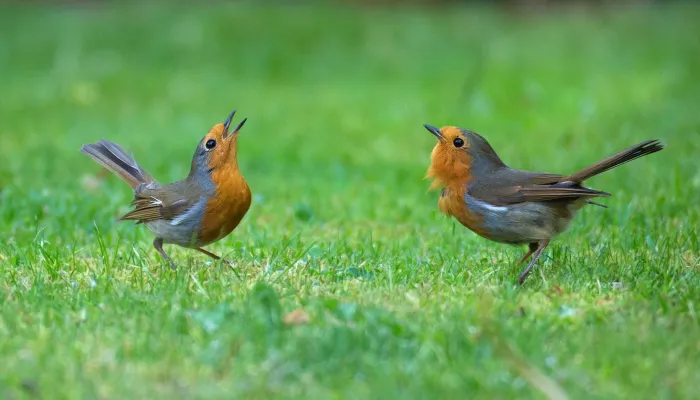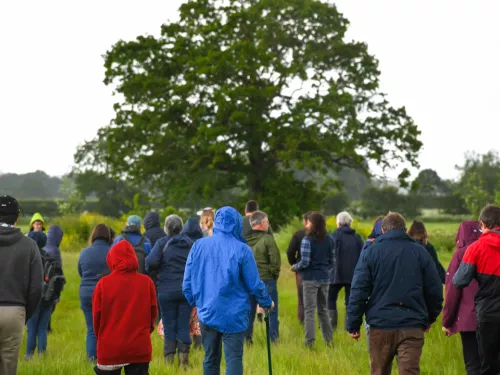
What are nightjars? An introduction to the elusive bird
The mysterious nightjar has fascinated humans for generations and their presence can be an indicator of healthy heathland ecosystems. Learn all about them here.

Here are a few you might spot:
Pigeon – urban areas, gardens, cliffs. The humble pigeon can be seen on the streets in every city, but they can also be quite lovely to watch in your garden and practice your binocular skills on. Watch how they bob their heads!
Robin – gardens, woodlands, hedgerows, parks. This classic Christmas-card bird is a lovely spot, and you’ll know it by its distinctive red breast.
Blackbird – gardens, woodlands, grasslands. A member of the thrush family, blackbirds are black or dark brown and can sometimes be seen in small groups in winter.
Blue tit – gardens, woodlands, hedgerows, parks, wetlands, orchards, scrublands. This common garden visitor can be easily recognised by its blue and yellow plumage.
Great tit – gardens, woodlands, hedgerows, parks, wetlands, orchards, scrublands. Larger than the blue tit, these birds have black caps and yellow chests.
Greenfinch – gardens, woodlands, orchards, farmland. Common in the south during winter, you’re quite likely to find one of these bright green fellows in Kent.
Song thrush – gardens, woodlands, hedgerows, scrubland. These small, round birds are more commonly seen in woodland and usually fly solo. Its song is the subject of much poetry!
Fieldfare – gardens, orchards, farmland. Drawn to orchard fruits throughout winter, you’re more likely to see one of these if you have an apple tree in the garden or nearby.
Nuthatch – gardens, woodlands, parks. These agile birds are about the same size as the great tit and have a grey back, a black strip over their eye, and an orange breast.
Great spotted woodpecker – woodlands. A special spot, the woodpecker is black and white with a red undertail. If you’re lucky enough, you may hear it drumming its beak against a tree!
Most of the birds listed above can also be seen year-round. So if you’re hoping for a rarer find, look to migratory birds.
Here are a few:
Merlin – coasts. Our smallest raptor, the resident merlin numbers in the UK are boosted in winter by visitors from Iceland.
Short-eared owl – marshes and grasslands. Spot this yellow-eyed owl hunting silently at dusk, with populations increased in winter by visits from Scandinavia and Russia.
Whooper swan – lochs and lakes. Over from Iceland, this recognisable large white birds weighs up to 15kg!
Siskin – rural gardens, parks, and woodlands. Your chances of seeing a bright yellow siskin are up in winter when populations migrate from Scandinavia.
Turnstone – coasts, saltmarshes, mudflats. Turnstones - brown and white speckled waders - arrive from Canada and Greenland to the warmer UK climate.
On the topic of coastal overwintering birds, it’s a good idea to be extra cautious of disturbance. Dogs, for example, can cause serious anxiety to these birds in need of a winter home. You can learn more about bird disturbance at our coastal reserves here and learn about our opposition to National Grid’s Sea Link plans for this reason.
Fancy giving birdwatching a go from home? We don’t blame you! If you’ve got a garden and garden-facing window, there’s plenty you can do to increase your chances of spotting them.
For one, avoid the temptation to cut back hedges. These can be crucial habitats for birds in the winter, and it follows that you’re more likely to see them if they have a home!
First, put out some feeding stations. You can do this in several ways, and you can choose to do a few of them or just one:
Use natural materials like pinecones to build your own easy feeders – here's our guide
Plant - or trim back covering plants to expose - natural food sources like berry plants
Create a platform - like a table - to place seeds on top of
Buy or build your own bird box and feeders
Bird baths (or even bowls of water) can provide much-needed water.
Place feeders at a good distance from your home so that any visiting birds aren’t frightened off by noise or activity. But of course, you’ll want to try to get a clear line of sight from your birdwatching window! You’ll also want to keep them clear of any shrubs from which cats could pounce on them.
It’s also important to keep feeders clean throughout the year to prevent the spread of disease, and only put out the feed that’s needed so you don’t attract unwanted guests.
If you can, provide birds with a variety of food types, like:
Seed and grains like millet, oats, sunflower seeds, and nyjer
Raisins and sultanas
Fat and suet balls
Insects like mealworms.
Your birdwatching activities can also contribute to important citizen science and survey projects like the Big Garden Birdwatch (26th-28th January). The RSPB uses the data collected about the species and numbers of birds spotted to understand the state of the UK’s bird population – including important insight into which birds could be in need of more help. Simply submit what you see to the RSPB.
Or, if you’re spotting outside of the Big Garden Birdwatch, you could submit an interesting sighting to the British Trust for Ornithology or record any and all spots to an app like eBird.
Above all else, we hope you have fun birdwatching – whenever and wherever you do it, and whatever you spot. It’s a lovely activity and frequent spotters will often tell you just how good it is for their wellbeing.
So, get out there (or onto a seat by the window in the warm...) and enjoy.
If you’re after some high-quality feeders and bird food, be sure to check out our range of Gardening and Wildlife products.

The mysterious nightjar has fascinated humans for generations and their presence can be an indicator of healthy heathland ecosystems. Learn all about them here.

In the last fifty years, both nightingales and turtle doves have suffered a population decline of over 90%. The usual threats of habitat degradation and climate change are partly to blame, but these two species are also at risk from a few more specific…

Rob Smith heads to Moat Farm Kent to visit a farmer who's lucky enough to live in a stronghold of a rare and elusive bird species - the nightingale. Find out the facts about Nightingales, listen to their beautiful song and learn how Michael Bax makes sure…